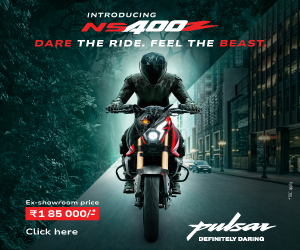
A fantastic dual-purpose bike is finally here!
The long wait is over
We have ridden the Hero Impulse and are glad to say that we have liked it! Hero MotoCorp has taken a bold step of launching proper dual-purpose bike for the first time in India and they haven’t gone wrong with it at all.
The bike is powered by a 149.2cc air-cooled, 2-valves engine that produces 13.2 PS peak power and 13.4 Nm peak torque. The bike’s geometry looks promising for off-roading action. Here are some details from the Hero Impulse. For a complete first ride review, wait and watch for the BIKE India November 2011 issue!
 Good quality plastics and bright colours make the Impulse an impressive looker |
 Mount for saddle bags is a good thought for the tourers |
 LEDs for the taillights look amazing |
 The 149.2cc engine delivers linear and smooth power |
 A great stunting machine with its light front end and good bottom end torque |

 All about the new R15
All about the new R15 It’s sharper and more aggressive in overall styling. This is the result of excellent implementation of the feedback received from the customers. The R15 now takes a number of cues from the R125 and a few from the R6. This basically applies to the new tail-piece that incorporates an LED tail-light and a split seat. There is a wider rear tyre, a radial one from MRF that measures 130/70-R17 and in front an upsized 90/80-R17. There is a new mid-cowl that is wider and suits the wide nose of the R15 better now. There is a new rear tyre hugger and a tinted visor too. As a whole, the bike looks more muscular and aggressive than before.
It’s sharper and more aggressive in overall styling. This is the result of excellent implementation of the feedback received from the customers. The R15 now takes a number of cues from the R125 and a few from the R6. This basically applies to the new tail-piece that incorporates an LED tail-light and a split seat. There is a wider rear tyre, a radial one from MRF that measures 130/70-R17 and in front an upsized 90/80-R17. There is a new mid-cowl that is wider and suits the wide nose of the R15 better now. There is a new rear tyre hugger and a tinted visor too. As a whole, the bike looks more muscular and aggressive than before. Yes. An excellent aluminium swing-arm has replaced the basic steel one. The new swing-arm is 55 millimetres longer than the old one, increasing the wheelbase. The seat height has been raised from 790 mm to 800 mm, making the revised R15 a little taller than the original. The bike looks superb with its new tail-piece and split seat, which will attract more attention. But it also entails a lot of pain for the pillion rider, as he/she will sit much higher and on a narrower seat. Yamaha have incorporated a few changes into the R15’s ECU mapping too, and claim better response to the throttle input, making the power and torque delivery linear than before. However, do not expect this to reflect in the output figures, which remain the same at the same revs as the earlier R15.
Yes. An excellent aluminium swing-arm has replaced the basic steel one. The new swing-arm is 55 millimetres longer than the old one, increasing the wheelbase. The seat height has been raised from 790 mm to 800 mm, making the revised R15 a little taller than the original. The bike looks superb with its new tail-piece and split seat, which will attract more attention. But it also entails a lot of pain for the pillion rider, as he/she will sit much higher and on a narrower seat. Yamaha have incorporated a few changes into the R15’s ECU mapping too, and claim better response to the throttle input, making the power and torque delivery linear than before. However, do not expect this to reflect in the output figures, which remain the same at the same revs as the earlier R15. 






 New application to make iPhone-owners happy
New application to make iPhone-owners happy

 Good news for all Bajaj Pulsar fans! Methods Automotive of Bengaluru has introduced a new replacement air-filter for this definitely male motorcycle.
Good news for all Bajaj Pulsar fans! Methods Automotive of Bengaluru has introduced a new replacement air-filter for this definitely male motorcycle.  This new filter is made by world renowned K&N Filters especially for the Bajaj Pulsar. It comes with a million-mile warranty, which means no need to replace the filter for 10 lakh kilometres. This filter is available for models starting from 2006. Priced at Rs 2,690, a good investment for your performance bike.
This new filter is made by world renowned K&N Filters especially for the Bajaj Pulsar. It comes with a million-mile warranty, which means no need to replace the filter for 10 lakh kilometres. This filter is available for models starting from 2006. Priced at Rs 2,690, a good investment for your performance bike.